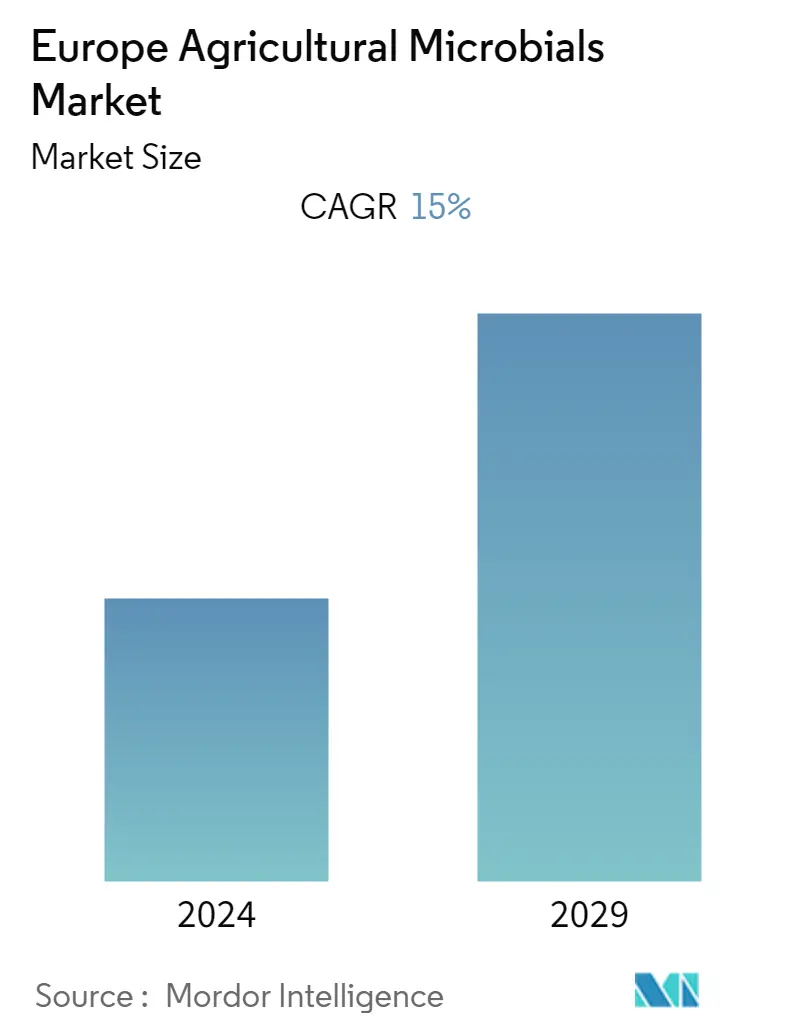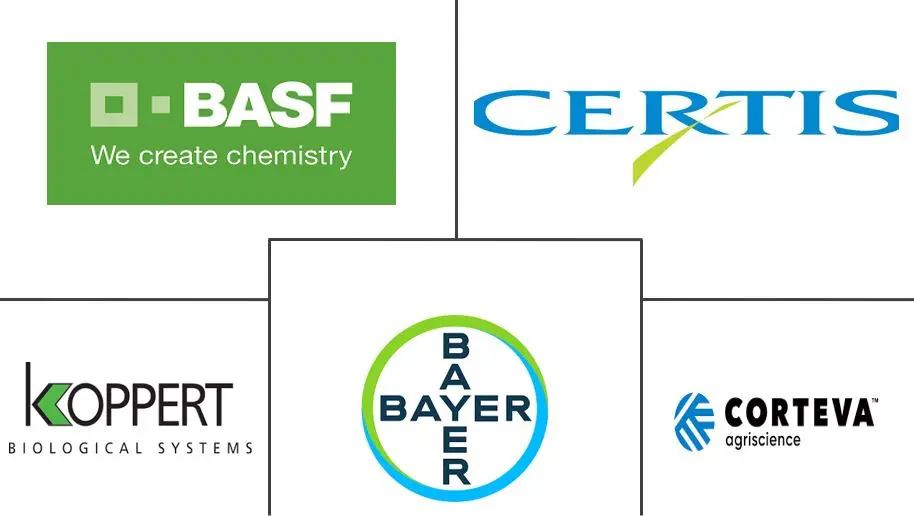Market Size of Europe Agricultural Microbials Industry

| Study Period | 2019 - 2029 |
| Base Year For Estimation | 2023 |
| Forecast Data Period | 2024 - 2029 |
| Historical Data Period | 2019 - 2022 |
| CAGR | 15.00 % |
| Market Concentration | Low |
Major Players
*Disclaimer: Major Players sorted in no particular order |
Europe Agricultural Microbials Market Analysis
The European Agricultural Microbials Market is estimated to witness a CAGR of 15% during the forecast period. Governing bodies throughout the world, particularly in Europe, are now implementing legislative mandates with the objective of decreasing dependence on pesticides in agriculture to increase consumer and environmental safety. In order to reduce the risks associated with pesticide applications and reduce dependency on their use, Directives are expected to promote low pesticide-input by implementing integrated pest management (IPM), and provide the means to establish the necessary conditions and measures to employ these practices, as well as to ensure the security of commercial products. One major trigger is stricter regulation surrounding chemical pesticides. These regulations mean that an increased number of chemicals are under regulatory scrutiny. This, along with a high hit rate in the screening and development of a microbial, makes microbial more attractive than conventional pesticides, when it comes to launching new products in the market. Europe's ban on neonicotinoid pesticides from 2013 to 2015 is an example and may well drive many of the region's growers to seek alternatives for biopesticides, in order to protect their crops. Recent changes to legislation in the European Union (EU) have paved the way for development and greater adoption of microbial pesticides over synthetic pesticides. Regardless of the fact that there still exists a lot of restraint throughout the agriculture industry to shift to newer technologies and the microbial industry is expected to continue to gather market share through switching with new products being rapidly launched. Biopesticides are relatively new to the market and it is immensely needed for the growers to learn more about them. Growers require assistance in case of: proper application timing and frequency, the most effective application methods to ensure thorough crop coverage, target pest identification, pest/disease pressure and life cycle dynamics, when adopting these new technologies.
Europe Agricultural Microbials Industry Segmentation
The report concerns agricultural microbials that can be defined as plant-associated microbes and plant and animal diseases. It also deals with the microbiology of soil fertility, such as microbial degradation of organic matter and soil nutrient transformations. The scope of the report includes countries in the European region.
| Type | |
| Bacteria | |
| Fungi | |
| Virus | |
| Others |
| Application | |
| Grains and Cereals | |
| Pulses and Oilseeds | |
| Commercial Crops | |
| Fruits and Vegetables | |
| Other Crop Types |
| Mode of Application | |
| Soil Treatment | |
| Foliar Spray | |
| Seed Treatment |
| Geography | |
| Germany | |
| United Kingdom | |
| France | |
| Spain | |
| Italy | |
| Netherlands | |
| Russia | |
| Rest of Europe |
Europe Agricultural Microbials Market Size Summary
The European Agricultural Microbials Market is poised for significant growth, driven by regulatory shifts aimed at reducing pesticide reliance and enhancing consumer and environmental safety. Legislative measures in Europe are encouraging the adoption of integrated pest management practices, which are expected to bolster the use of microbial pesticides as alternatives to conventional chemical options. This shift is further supported by the increasing scrutiny of chemical pesticides and the rapid development of microbial solutions, making them more appealing for new product launches. The region's historical ban on neonicotinoid pesticides has already prompted growers to explore biopesticides, and recent EU legislative changes are facilitating the broader adoption of microbial pesticides. Despite challenges in transitioning to new technologies, the microbial industry is anticipated to gain market share as new products are introduced, addressing the need for growers to understand application techniques, pest identification, and crop coverage.
The market for agricultural microbials in Europe is also benefiting from the expansion of organic farming, with a notable increase in organic cultivation areas. As conventional pesticides become less effective due to pest resistance, growers are increasingly turning to biological options, which offer effective pest control with lower environmental impact. Germany, in particular, is leading the market, with a strong focus on sustainable agriculture and soil preservation. The country's growing organic farming sector is expected to drive demand for agricultural microbials, contributing to market growth. The European market remains fragmented, with major players like BASF SE, Bayer Cropscience AG, and Corteva Agriscience competing for market share through strategic acquisitions and product innovation, reflecting a rapid shift towards microbial-based agricultural solutions.
Europe Agricultural Microbials Market Size - Table of Contents
-
1. MARKET DYNAMICS
-
1.1 Market Overview
-
1.2 Market Drivers
-
1.3 Market Restraints
-
1.4 Porter's Five Forces Analysis
-
1.4.1 Threat of New Entrants
-
1.4.2 Bargaining Power of Buyers/Consumers
-
1.4.3 Bargaining Power of Suppliers
-
1.4.4 Threat of Substitute Products
-
1.4.5 Intensity of Competitive Rivalry
-
-
-
2. MARKET SEGMENTATION
-
2.1 Type
-
2.1.1 Bacteria
-
2.1.2 Fungi
-
2.1.3 Virus
-
2.1.4 Others
-
-
2.2 Application
-
2.2.1 Grains and Cereals
-
2.2.2 Pulses and Oilseeds
-
2.2.3 Commercial Crops
-
2.2.4 Fruits and Vegetables
-
2.2.5 Other Crop Types
-
-
2.3 Mode of Application
-
2.3.1 Soil Treatment
-
2.3.2 Foliar Spray
-
2.3.3 Seed Treatment
-
-
2.4 Geography
-
2.4.1 Germany
-
2.4.2 United Kingdom
-
2.4.3 France
-
2.4.4 Spain
-
2.4.5 Italy
-
2.4.6 Netherlands
-
2.4.7 Russia
-
2.4.8 Rest of Europe
-
-
Europe Agricultural Microbials Market Size FAQs
What is the current Europe Agricultural Microbials Market size?
The Europe Agricultural Microbials Market is projected to register a CAGR of 15% during the forecast period (2024-2029)
Who are the key players in Europe Agricultural Microbials Market?
BASF SE, Bayer Cropscience AG, Corteva Agriscience, Koppert Biological Systems and Certis USA LLC are the major companies operating in the Europe Agricultural Microbials Market.

